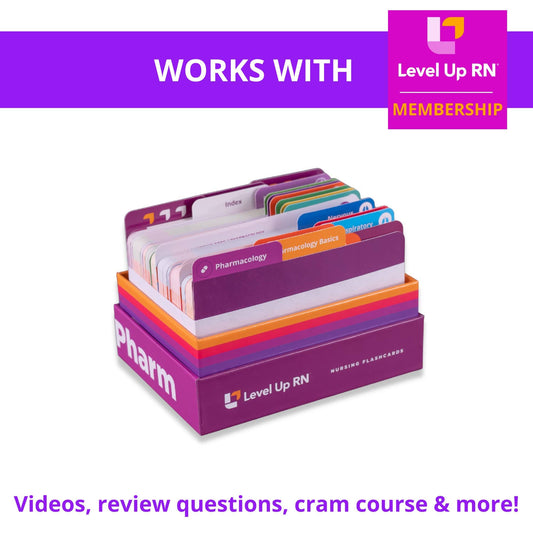In this article, we cover some important respiratory medications including corticosteroids, leukotriene receptor antagonists, as well as antitussives.
This video follows along with our Pharmacology Flashcards.
Pharmacology - Nursing Flashcards
Corticosteroids
What are corticosteroids?
Corticosteroids are a class of drug that lowers inflammation in the body and reduces immune system activity. We’ll focus on locally-acting steroids for the respiratory system here, including inhalers and intranasal corticosteroids. There are a number of medications that fall within this drug class and include beclomethasone (QVAR), mometasone (Asmanex), budesonide (Pulmicort), and fluticasone (Flovent).
Indications
Localized corticosteroids can be used year-round to treat asthma and rhinitis (runny nose).
Mode of action
Corticosteroids decrease inflammation locally by acting on cells that are responsible for inflammatory response.
Corticosteroids side effects
Side effects are much less than if taking a systemic steroid but can include headache, pharyngitis (sore throat), and a possible fungal infection from candidiasis.
Patient teaching for corticosteroids
An important teaching you’ll need to discuss with your patient is that after administration, they need to rinse their mouth out to decrease the risk of contracting a possible fungal infection from candidiasis (a type of yeast infection, also called thrush).
Corticosteroids are often used alongside bronchodilators for asthma. If your patient is going to be using a bronchodilator like albuterol, in conjunction with a corticosteroid, they should administer the bronchodilator first to help open up the airways, wait five minutes, and then administer the corticosteroid.
 If you take fluticasone for your nasal congestion, it will let you be able to play the flute.
If you take fluticasone for your nasal congestion, it will let you be able to play the flute.
(Playing the flute while you're congested would probably not work out, and that's why you need the fluticasone.)
Leukotriene receptor antagonists
Indications
Leukotriene receptor antagonists are a class of drug used to treat asthma and the prevention of exercise-induced bronchoconstriction (which causes wheezing and shortness of breath). Two medications that fall under this class include montelukast and zafirlukast.
Mode of action
Leukotrienes are inflammatory chemicals released in response to an allergen. Leukotriene receptor antagonists work to decrease the effect of leukotrienes in the body, which in turn reduces airway inflammation and bronchoconstriction.
 Meds that end in -lukast decrease the effect of leukocytes.
Meds that end in -lukast decrease the effect of leukocytes.
Side effects
The key side effect that you will see with leukotriene receptor antagonists is headaches. With zafirlukast, you may also see an increase in liver enzymes.
Administration
One important thing to remember about montelukast and zafirlukast is that they are oral medications, not inhaled or intranasal like many other respiratory drugs. A patient should take montelukast in the evening or two hours before exercise. Zafirlukast should be taken on an empty stomach.
Antitussive Medications
Antitussive medications are used to treat a patient's cough. If you break down antitussive you get anti- and then -tussive, which comes from tussis meaning cough. Specifically, these medications should be used for a dry cough only. A patient who has a productive cough (i.e., producing phlegm), should not be given an antitussive. We want patients to cough up the gunk, rather than allow it to sit in their lungs.
There are three main antitussives you should be familiar with for your pharmacology exam and the NCLEX.
 Remember A, B, C, D = Antitussives include benzonatate, codeine, and dextromethorphan.
Remember A, B, C, D = Antitussives include benzonatate, codeine, and dextromethorphan.
Benzonatate
Mode of action
Benzonatate works by having an anesthetic (numbing) effect on the vagal nerve receptors in the airway. This relaxes the receptors so they are not as quick to create a cough as a reflex.
Side effects
Benzonatate side effects include sedation, constipation, as well as GI upset.
Codeine
Mode of action
Codeine works by binding to opioid receptors in the central nervous system, and reducing activity in the area of the brain that triggers coughing, so coughs are suppressed.
Side effects
Codeine is an opioid medication so it’s going to have some serious side effects. They include sedation, respiratory depression, hypotension, constipation, and GI upset.
Dextromethorphan
Mode of action
Dextromethorphan, often known by its brand name Delsym, works by suppressing the cough reflex in the medulla. Both codeine and dextromethorphan work centrally (meaning acting on the brain) rather than locally (acting on the throat).
Side effects
The side effects usually seen with dextromethorphan are fairly minor and may include dizziness and possible sedation at high doses.
The Pharmacology Video Series is intended to help RN and PN nursing students study for nursing school exams, including the ATI, HESI and NCLEX.


